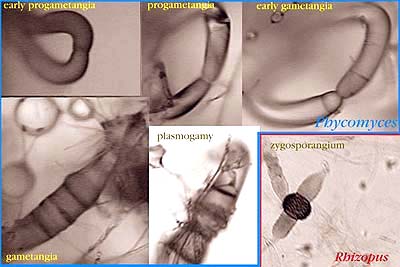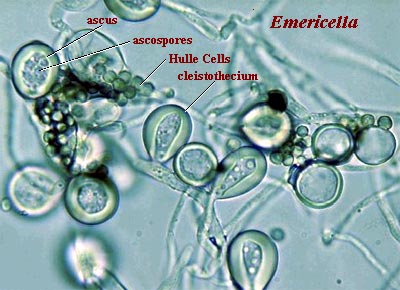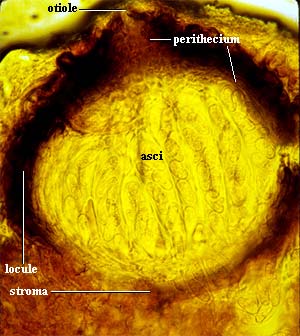
| Palaeos |  |
Glossary |
| Fungi | Glossary G |
| Page Back | Unit Back | Fungi | Dendrogram | References | Taxon Index | Pieces |
| Page Next | Unit Next | Unit Home | Unit Dendrogram | Unit References | Glossary | Time |
The initial entries in this glossary were assembled in considerable haste. I tender my apologies to Jonathan Dixon, late of the University of Manchester, from whose glossary I borrowed liberally. Various other gleanings are credited individually.
 Gametangium: a single-celled structure
producing gametes (sex cells) or gametic nuclei.
Gametangium: a single-celled structure
producing gametes (sex cells) or gametic nuclei.
Ghost lineage: a period of time during which a clade is inferred to exist, but is not known in the fossil record. As discussed in the text, Ascomycota and Basidiomycota are sister groups. Basidiomycota is known from the Early Devonian. This means that Ascomycota must have diverged from Basidiomycota at least this early. However, no definitive ascomycete remains are known older than the Missisippian. Thus, Ascomycota has a ghost lineage spanning the 60 My between these two periods.
Gleba: fleshy spore-producing inner mass of a clestothecium (enclosed ascocarp), e.g. a puffball or stinkhorn. A gleba on the outside of an open ascocarp is referred to as a hymenium. The term is also used in a slightly different sense to mean the mass of spores left as the asci disintegrate.
Glucan: a polysaccharide composed of repeating units of glucose.
Glucan, beta: b-Glucans consist of linear unbranched polysaccharides of linked b-(1®3)- and b-(1®4)-D-glucopyranose units. They are (together with chitin) an important component of the cell wall in Basidiomycota and Ascomycota. See image at Ascomycota.
Glucose: see The Cell Wall.
Glycoprotein: a protein to which sugar molecules are bound, often in short chains ("oligosaccharides"). The free hydroxyl groups on the sugar molecules are often strongly hydrated, resulting in a matrix which contains considerable water and a surface with low friction. The hydroxyl groups also form hydrogen bonds with other sugars, creating a complex of flexible cross-links between individual protein molecules. Animal "gristle" is a good example of a glycoprotein matrix.
Glycoside: see The Cell Wall.
Haploid: a nucleus is haploid if it contains only one copy of each non-redyndant gene. In Fungi, it is necessary to distinguish between haploid nuclei and haploid cells. A hypha may contain several haploid nuclei (either identical or from different individuals). Technically, the cell is diploid or polyploid. However, there may be no diploid nuclei.
Haworth diagram: See, The Cell Wall.
Hemiacetal: See, The Cell Wall.
Heterogametes: male and female gametes that are morphologically distinguishable.
Heterothallic: describes fungi in which two genetically distinct but compatible mycelia must meet before sexual reproduction can take place
Heterotroph: an organism which obtains energy from the oxidation of organic matter.
Homing Endonuclease: an enzyme which catalyzes the insertion of an intron into chromosomal DNA. Homing enzymes may be coded by the intron itself, or may come from elsewhere. Homing enzymes may work in a variety of ways. For example they may act as, or work with, a reverse transcriptase to create a DNA copy of an intron RNA. Alternatively, they may directly ligate the intron transcript (RNA) into the DNA od the "host," relying on the host DNA repair machinery to convert the inserted sequence into double-stranded DNA.
Homothallic: describes fungi in which a single strain can undertake sexual reproduction; self-compatible.
 Hülle
Cell: in some ascomycetes,
"thick-walled globose
cells (Hülle cells) develop by budding at the tips of specialized hyphae.
Hülle cells envelop the developing cleistothecium and may serve as nurse cells."
Wu & Miller (1997).
Image by David Geiser from a Ball State University
site.
Hülle
Cell: in some ascomycetes,
"thick-walled globose
cells (Hülle cells) develop by budding at the tips of specialized hyphae.
Hülle cells envelop the developing cleistothecium and may serve as nurse cells."
Wu & Miller (1997).
Image by David Geiser from a Ball State University
site.
Hydroxyl group: see The Cell Wall.
Hymenium: "The hymenium is the layer of cells containing the spore-bearing cells (usually basidia or asci) of the fungus. The hymenophore is a collective term for the fleshy structures that bear the hymenium. Thus, in a gilled mushroom, all the gills constitute the hymenophore, and the hymenium is the layer of cells on the surface of those gills. Although the hymenophore may be convoluted and enclosed within the fruiting body, the hymenium still has to be, in some sense, on the 'outside' of the hymenophore in order for either of these structure to qualify for their names. Otherwise, you have a gleba, inside a peridium." hymenium.
Hypha: "(plural hyphae) is a long, branching filament that, with other hyphae, forms the feeding thallus of a fungus called the mycelium. Hyphae are also found enveloping the gonidia in lichens, making up a large part of their structure. A typical hypha consists of a tubular wall, usually made of chitin, which surrounds, supports, and protects the cellss that compose a hypha. For most fungi, a cell within a hyphal filament is separated from other cells by internal cross-walls called septa (singular septum). Some forms of parasitic fungi have a portion of their hyphae modified to form haustoria that are able to penetrate the tissues of a host organism. Similar, yet mutualistic forms of penetrating hyphae are called mycorrhizae and are important in assisting nutrient and water absorption by plants." Hypha
Hyphal body: portion of mycelium that becomes separated from remainder of thallus.
Imperfect state: asexual state of a fungus, also known as an anamorph in a life cycle.
 Intron:
An intron, generically, is a piece of DNA which is transcribed into RNA but does
not form part of the final gene product. In one fashion or another, it
must be spliced out of the RNA before the RNA can be used for translation,
ribosome formation, etc. Group I introns are large introns whose
RNA product has an extremely complex secondary structure. See image
from Haugen et
al. (2004). The RNA itself (with or without cofactors such as
nucleotides or metal ions) catalyzes its own removal from the initial
RNA transcript. That is, it functions as a ribozyme, an enzyme made up of
RNA. Most Group I introns then catalyze their own circularization. See,
generally, Hemiascomycetous
Yeast Spliceosomal Introns. Mobile Group I elements may also encode a homing
endonuclease, or use an endonuclease native to the host, to insert a DNA
copy of the transcribed intron into the homologous location on a sister
chromosome, or into another copy of the "home" gene in the case of
genes present in multiple copies. The point of insertion is never random,
and tends to be quite specific to a particular gene. A Spliceosomal
Intron, at the opposite extreme, is a short (c. 40 bp) intron which serves
as a substrate for splicing enzymes which remove the intron and probably also
perform various regulatory roles, including adding the 3'-poly(A)
"tail" which acts as a shipping label, specifying that the nuclear RNA
is a messenger RNA which can be exported to the cytoplasm for translation.
Various regulatory roles and one possible template for the evolution of the
system are reviewed by Lynch
& Kewalramani (2003). Group I and spliceosomal introns are likely
to be related, with Group I introns gradually becoming simplified and more
dependent on the host cell until they are eventually reduced to spliceosomal
introns or disappear altogether.
Intron:
An intron, generically, is a piece of DNA which is transcribed into RNA but does
not form part of the final gene product. In one fashion or another, it
must be spliced out of the RNA before the RNA can be used for translation,
ribosome formation, etc. Group I introns are large introns whose
RNA product has an extremely complex secondary structure. See image
from Haugen et
al. (2004). The RNA itself (with or without cofactors such as
nucleotides or metal ions) catalyzes its own removal from the initial
RNA transcript. That is, it functions as a ribozyme, an enzyme made up of
RNA. Most Group I introns then catalyze their own circularization. See,
generally, Hemiascomycetous
Yeast Spliceosomal Introns. Mobile Group I elements may also encode a homing
endonuclease, or use an endonuclease native to the host, to insert a DNA
copy of the transcribed intron into the homologous location on a sister
chromosome, or into another copy of the "home" gene in the case of
genes present in multiple copies. The point of insertion is never random,
and tends to be quite specific to a particular gene. A Spliceosomal
Intron, at the opposite extreme, is a short (c. 40 bp) intron which serves
as a substrate for splicing enzymes which remove the intron and probably also
perform various regulatory roles, including adding the 3'-poly(A)
"tail" which acts as a shipping label, specifying that the nuclear RNA
is a messenger RNA which can be exported to the cytoplasm for translation.
Various regulatory roles and one possible template for the evolution of the
system are reviewed by Lynch
& Kewalramani (2003). Group I and spliceosomal introns are likely
to be related, with Group I introns gradually becoming simplified and more
dependent on the host cell until they are eventually reduced to spliceosomal
introns or disappear altogether.
Karyogamy: fusion of two (haploid) nuclei.
Ligand :
see The
Cell Wall.
:
see The
Cell Wall.
Locule: generally, in botany, a locule is a small chamber in which a reproductive structure develops. In the ascomycetes, it refers to a small chamber in the hymenium (generalized reproductive tissue) in which a perithecium develops.
LUCA: Last Universal Common Ancestor. The last common ancestor of all extant species: Eubacteria, Archaea, and Eukarya.
| Page Back | Page Top | Unit Home | Page Next |
checked ATW050915